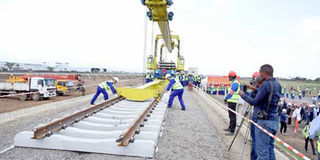Growing fortunes: SGR changes the face of Narok

Contractors at work on Phase 2A of the SGR in Suswa, Narok County. PHOTO | FILE | NATION
What you need to know:
Governor Samuel ole Tunai said there was more in store for residents following the completion of the railway in the area even if its construction is not extended to western Kenya.
He said the railway will ease transportation of wheat, barley and other produce to Nairobi and the Mombasa port. Narok County leads in the production of cereals.
The building of the standard gauge railway (SGR) and improvement of roads following devolution has transformed Narok County and increased the value of land.
New buildings are also coming up in Maai Mahiu, Suswa and Satellite due to SGR, with the areas also experiencing increased demarcation of land.
DRY PORT
In an interview with the Saturday Nation, Narok Governor Samuel ole Tunai said there was more in store for residents following the completion of the railway in the area even if its construction is not extended to western Kenya.
The governor said the value of land has risen, with a high number of people buying in anticipation of later selling at higher prices.
“An SGR station is being opened in Narok. The railway is already transforming Narok’s economy even before it starts operations,” said Mr Tunai.
Speaking at the Kichwa Tembo Tented Camp in Maasai Mara, he said the railway will ease transportation of wheat, barley and other produce to Nairobi and the Mombasa port. Narok County leads in the production of cereals
A dry port and an SGR substation will also be built in Suswa, Mr Tunai added, and will create 21,000 jobs.
“The impact of SGR and the hundreds of kilometres of roads being done in Narok is immense. Businesses will grow. The economy is going to grow fast,” said Mr Tunai, a close ally of President Uhuru Kenyatta and his deputy William Ruto.
Mr Tunai said the county government is promoting alternative dispute resolution to address land problems and that “it is working”.
400KM ROADS
The national government is tarmacking about 400km of roads in the vast county that measures about 17,944 square kilometres. Governor Tunai’s government has also acquired equipment to improve roads for the success of the county’s Integrated Development Plan and the Big Four agenda.
The infrastructure development is to open up the county, a major producer of wheat, barley, maize and potatoes and enable growers to access markets.
The county, which also produces sugarcane and livestock products, lacked roads in some areas before devolution.
“We decided to buy our own equipment and established the Narok Roads Authority headed by an experienced person. The authority has been functioning well and rehabilitating roads,” said Mr Tunai. In an interview with the Saturday Nation, he said all access roads are being gravelled to ease access to markets.
The county, he said, was also closely working with the national government to build roads, a relationship that he said would highly transform the county’s economy.
A survey by the Saturday Nation indicated that the value of land has tripled in Maai Mahiu, Suswa and Satellite where an industrial park — to be served by the railway — will be located.
A 50m by 100m parcel that used to fetch Sh300,000 in Suswa two years ago is now selling at Sh1.5 million. Many of those who bought land in Suswa are from Nairobi, Kisii, Naivasha and Nakuru.
But the failure to extend the railway to Kisumu has dampened the hopes of some investors.
HOAX PROJECTS
When Mr Joseph Kamau bought two acres of land adjacent to Suswa, he thought he would soon reap big if the SGR passed through Narok to Bomet, Sotik and finally to Kisumu.
Speaking to the Saturday Nation by phone, Mr Kamau said he bought the land at Sh3 million last year, but feared he could have burnt his fingers. “I was attracted to Suswa because of the 120km Nairobi-Naivasha line, which I hear cost Sh150 billion. I believed I would set up business near the SGR phase 2A terminus in Suswa, but it now seems impossible,” he added.
Mr Samson Momanyi, who also bought land in the area, said the notion they had was that the SGR project would be “very huge because of the dry port and create a lot of opportunities”.
“I was attracted to the dry port in Kedong Ranch that partly touches the Suswa market centre. I thought once the project is completed, Suswa will grow big as most container freights will be located there. I had a plan to put up a hotel, the cheap hotels for truck drivers or build some average housing units to serve the workforce there,” he added.
He bought the land for about Sh2.5 million per acre on the outskirts of the market.
Narok East MP Lemanken Aramat expressed concern over the rush to buy land in Suswa at exorbitant prices to cash in on some “hoax projects”, saying the phenomenon has left many families in misery. “Why are some Kenyans so dumb?” he asked.
TIME BOMB
The MP decried uncontrolled sale of land along the SGR corridor, warning it was turning out to be a “ticking time bomb” for locals who might be displaced.
Suswa residents said they were already feeling the effects of the railway, mainly in terms of infrastructure and the value of their land.
Parsayia Kisongoi, a community leader, said that for years, the area had been neglected in terms of infrastructure, but this had changed since building of the railway began.
“We have seen the value of land rise and the contractors have assisted in building some classrooms, water pans and even rehabilitating rural roads and we are grateful,” he said.
Kenya failed to sign another loan deal with China to fund the completion of the SGR from Naivasha to Malaba during the recent Second Belt and Road Initiative in Beijing, China, with State House saying it was not part of the agenda.




